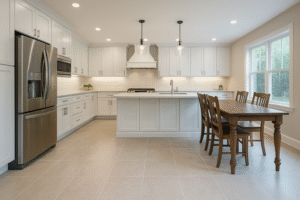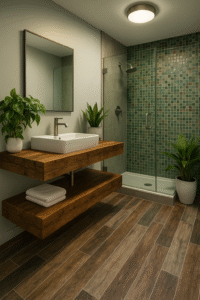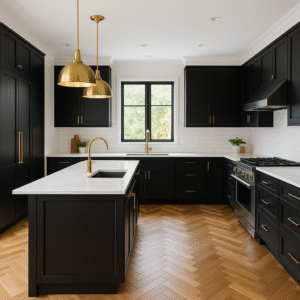Choosing the Best Flooring for Your Bathroom Remodel
Bathroom remodel projects are among the most rewarding home improvements, both in terms of bathroom remodel ROI and the satisfaction of transforming a dated space into a spa-like retreat. However, choosing the right bathroom flooring can be overwhelming because the materials must balance durability, beauty, and cost. At DBR Construction, your trusted bathroom remodeling contractors, we help homeowners navigate every step of their bathroom renovation, from layout and materials to finishes and lighting that tie the entire design together.
Whether you’re planning a small bathroom remodel or a luxury upgrade, this guide explores the best flooring options, discusses bathroom remodel cost considerations, and offers practical tips to avoid common pitfalls. You’ll also learn how your flooring choice impacts your overall home remodeling ROI and how to integrate it seamlessly with your kitchen remodel if you’re renovating multiple areas of your home for a consistent, modern look.

Why Bathroom Flooring Matters in Your Bathroom Remodel
Your choice of bathroom flooring is more than just an aesthetic decision—it’s an investment in your home’s longevity and comfort. Bathroom floors must withstand daily exposure to water, humidity, soap residue, and cleaning agents. They also need to be comfortable underfoot and safe for all family members, especially in households with children or elderly residents who are more susceptible to slips.
The right bathroom tiles, bathroom flooring, and finishes create a cohesive look, improve durability, and boost your property’s resale value when it’s time to sell. In fact, upgraded flooring is one of the most commonly cited features buyers look for when they search listings and browse online galleries. When homeowners search for bathroom remodeling near me or bathroom remodeling contractors, flooring selection is one of the top priorities in their bathroom remodel checklist, often determining the overall project budget and timeline.
Durable flooring also plays an essential role in maintaining indoor air quality and preventing hidden mold or mildew problems beneath the surface. That’s why professional installation and high-quality materials are critical if you want a bathroom that looks beautiful and performs flawlessly for years to come.
Popular Bathroom Flooring Options
Here’s an in-depth look at some of the most popular and reliable flooring materials commonly used in bathroom renovations, each with unique pros and cons to help you choose the right fit for your lifestyle and budget.
Ceramic and Porcelain Tile
Bathroom tiles made from ceramic or porcelain remain the gold standard for durability, water resistance, and design variety. Porcelain is denser and less porous than standard ceramic tile, making it a fantastic choice for wet zones like the shower enclosure, around bathtubs, and along splash-prone vanity walls.
Modern tile comes in hundreds of shapes, colors, and textures, from classic white subway tile to intricate mosaics or wood-look planks that mimic natural materials. If you prefer a timeless style with unlimited patterns and design possibilities, tile is an excellent way to customize your space without sacrificing performance.
Pros:
- Waterproof and highly resistant to staining when properly sealed
- Affordable options for every bathroom renovation budget
- Available in wood, stone, concrete, and patterned looks to match any style
- Easy to clean and maintain with regular sweeping and mopping
Cons:
- Cold underfoot in cooler months (although underfloor heating can solve this)
- Grout requires sealing periodically to prevent staining or mildew
If you plan a DIY bathroom remodel, keep in mind that tile installation requires precise layout, leveling, and grouting to look professional.
Luxury Vinyl Plank (LVP)
Luxury vinyl plank flooring is quickly becoming the go-to material for affordable remodeling because it combines good looks with impressive performance. High-quality LVP convincingly mimics wood and stone while offering exceptional water resistance, making it a popular choice in bathrooms, kitchens, and mudrooms alike.
Pros:
- Budget-friendly pricing for cost-conscious remodels
- Softer and warmer feel underfoot than tile or stone
- Simple installation—some types click together as a floating floor
- Low maintenance with no need for sealing
Cons:
- Not as long-lasting as tile or natural stone
- Susceptible to dents or scratches from heavy furniture or sharp objects
Homeowners considering a DIY bathroom remodel often choose LVP because it can be installed over many existing floors, saving time and labor costs.
Natural Stone
For high-end bathroom remodel ideas, natural stone flooring offers unmatched luxury and sophistication. Slate, marble, limestone, or travertine floors can instantly elevate the feel of any bathroom, transforming it into a serene retreat reminiscent of high-end spas or boutique hotels.
However, natural stone requires more maintenance and a higher bathroom remodel budget to install and care for properly.
Pros:
- Stunning natural aesthetics with unique veining and rich textures
- Increases property value and boosts bathroom remodel ROI
- Durable and long-lasting when properly sealed and maintained
Cons:
- Expensive material and installation costs compared to tile or vinyl
- Requires sealing to protect against stains and water penetration
- Some types can be slippery when wet, requiring textured finishes or mats for safety
When you partner with DBR Construction, we’ll guide you through the pros and cons of each material to help you make an informed decision that aligns with your goals and budget.

Bathroom Remodel Cost Factors for Flooring
Understanding your bathroom remodel cost early in the process helps you set realistic expectations and avoid sticker shock. Flooring is one of the biggest line items in any bathroom renovation budget, especially if you’re upgrading subfloors or investing in premium materials.
Here are key cost considerations:
- Material Cost: Vinyl flooring may start as low as $2–$5 per square foot, while premium porcelain or designer tiles range from $8–$15 per square foot. High-end natural stone can exceed $20 per square foot.
- Labor: Professional installation costs vary but generally range from $5–$15 per square foot, depending on material complexity and site conditions.
- Preparation: Removing old flooring, repairing or leveling subfloors, and installing moisture barriers can add labor time and material costs.
- Sealing and Waterproofing: Porous materials like natural stone require sealing after installation and periodic resealing to maintain water resistance.
When you work with DBR Construction, we provide a transparent, itemized estimate as part of your bathroom remodel checklist so you can plan confidently and avoid surprise expenses later.
Flooring Trends in Modern Bathroom Remodeling
Looking to make your remodel stand out? Here are the latest flooring trends influencing bathroom renovation and home improvement projects in Jersey City and beyond:
Heated Flooring
Radiant heat beneath tile or stone floors adds a level of comfort that feels indulgent every time you step out of the shower. Heated floors not only keep toes warm in winter but can also improve overall energy efficiency by helping regulate room temperature. It’s especially popular in small bathroom remodels where every detail contributes to a sense of luxury.
Large-Format Tiles
Oversized tiles are gaining popularity because they reduce the number of grout lines, making the floor easier to clean and visually less cluttered. Large-format porcelain or ceramic tiles can help a small bathroom feel bigger and more streamlined, lending a modern, minimalist vibe that pairs well with floating vanities and frameless glass showers.
Eco-Friendly Materials
More homeowners are prioritizing sustainability in their remodels. Recycled tiles, reclaimed wood-look porcelain, and low-VOC adhesives are eco-friendly choices that align with green living principles. Not only do these materials reduce environmental impact, but they also contribute to healthier indoor air quality—an important consideration for families.
Common Bathroom Flooring Problems and Solutions
Even the most beautiful floors can fail if installed improperly or neglected over time. Bathroom flooring has to contend with daily splashes, frequent cleaning, and constant foot traffic, which means small issues can escalate quickly if not addressed. Below are some of the most common problems—and how DBR Construction helps you prevent or solve them:
- Water Damage:
Incorrect sealing, poor grout application, or failing caulk can let water seep under tiles or vinyl. This can lead to mold, mildew, and even structural rot in the subfloor. Our team uses industry-standard waterproof membranes, professional-grade sealants, and proper slope to drains, ensuring moisture is safely managed. - Cracking:
Subfloor movement from settling foundations or temperature changes can cause tiles or grout lines to crack. Low-quality adhesives also lose their grip over time. We use premium setting materials and advanced leveling systems to maintain a strong, flexible bond that accommodates minor shifts without damage. - Slippery Surfaces:
High-gloss tiles or polished stone may look stunning but can become dangerously slippery when wet—especially in homes with kids or seniors. We recommend slip-resistant finishes or textured tile surfaces to improve safety without sacrificing style. - Mismatched Materials:
Using clashing colors or patterns between floors and walls can create a disjointed look that reduces your bathroom remodel ROI. Our experienced designers guide you in selecting complementary finishes that enhance the sense of space and visual flow. - Staining and Discoloration:
Unsealed grout and porous stone can absorb spills from bath products, creating unsightly stains. We protect your investment by applying appropriate sealers and showing you how to care for your new floors.
By partnering with DBR Construction, you get expert installation and guidance to keep your floors beautiful and functional for decades.
Integrating Flooring With Other Bathroom Remodel Elements
Your flooring doesn’t exist in isolation—it interacts with every surface and fixture in the bathroom. A thoughtfully integrated design ensures the space feels harmonious and inviting rather than cluttered or chaotic. When planning your remodel, consider how flooring connects to:
- Bathroom lighting:
The color temperature of your lights can dramatically change the look of flooring. Bright white LEDs highlight textures and grains, while warm lighting softens contrasts. Recessed lighting or sconces can create striking shadows on textured tiles. - Bathroom storage ideas:
Vanity cabinets, shelving, and linen closets should coordinate with your flooring for a cohesive aesthetic. For example, warm wood tones pair beautifully with earthy tiles, while crisp white cabinetry contrasts nicely with darker stone. - Bathroom shower remodel:
Using the same tile on the floor and shower walls creates an upscale, continuous look. Alternatively, contrasting the shower floor with a coordinating accent tile can define zones within the bathroom. - Bathroom bathtub remodel:
Around freestanding tubs, ensure the flooring is properly sloped and sealed to handle splashes and prevent leaks.
These small but important decisions elevate a remodel from good to exceptional. Our team provides samples and mood boards to help you visualize how each component will come together.
Planning Your Bathroom Remodel Timeline
Timing is critical, especially if you have only one bathroom in your home. Delays can be disruptive, so it helps to plan in detail and have realistic expectations. Here’s a general timeline you can expect:
- 1–2 days: Demolition and preparation
- Removing old flooring and fixtures
- Inspecting the subfloor for damage or moisture issues
- Ordering materials and confirming measurements
- 2–3 days: Subfloor and waterproofing installation
- Repairing or replacing subfloor sections as needed
- Installing cement board, waterproof membranes, and moisture barriers
- 3–5 days: Flooring installation
- Laying tile, vinyl planks, or stone in a precise layout
- Allowing adhesives and grout to cure properly
- Making any necessary cuts around fixtures and transitions
- 1–2 days: Grouting, sealing, and finishing touches
- Sealing grout lines or stone surfaces
- Installing baseboards and trim
- Final cleaning and inspection
Complex bathroom renovation projects—especially those involving plumbing or structural changes—may extend this timeline by several days or more. Clear communication with your contractor is essential to avoid surprises and keep the project moving smoothly.

Kitchen Remodel Flooring Considerations
Many homeowners tackling bathroom remodeling also use the opportunity to upgrade their kitchen, ensuring consistent style and quality throughout the home. Your kitchen remodel brings unique challenges and priorities. When choosing flooring, think about:
- Water and stain resistance:
Kitchens see frequent spills—water, oils, sauces—so the flooring must resist staining and be easy to clean. Porcelain tile and luxury vinyl plank are excellent options. - Popular materials:
Engineered hardwood provides a warm, natural look and can handle moderate moisture. Large-format tiles make the space feel expansive, while LVP offers an affordable, durable alternative. - Kitchen layout design:
Open-concept homes benefit from flooring that runs seamlessly from kitchen to dining or living spaces, visually connecting zones and making rooms appear larger. - Eco-friendly kitchen remodel choices:
Recycled tiles, low-VOC adhesives, and sustainably sourced wood products can reduce your project’s environmental impact.
Every material has trade-offs, so it’s smart to evaluate priorities—durability, budget, appearance—before making a final selection.
Kitchen Remodel Flooring Cost and ROI
Flooring is one of the most significant investments in any kitchen remodel, but it also offers one of the highest returns. The right floors can enhance both daily enjoyment and resale value. Here’s what to expect in terms of pricing:
- Vinyl:
$3–$7 per sq. ft., ideal for tight budgets and fast installation timelines. - Tile:
$8–$15 per sq. ft., offering durability and design flexibility. - Hardwood:
$10–$20 per sq. ft., prized for timeless appeal but requires more maintenance.
Professional installation is strongly recommended to avoid issues with leveling, transitions, and compliance with remodeling permits and regulations. A well-installed floor can last decades, paying dividends in both beauty and ROI.
How to Match Flooring With Kitchen Cabinets and Countertops
Coordinating flooring with cabinets and countertops ensures your remodel looks polished and intentional rather than piecemeal. Here’s how to create harmony:
- Kitchen cabinets:
Light flooring under dark cabinets creates contrast and makes cabinetry pop. Conversely, tone-on-tone combinations (e.g., medium oak floors with taupe cabinets) can feel calm and cohesive. - Kitchen countertops:
If you have dramatic veining or bold colors in your countertops, balance it with simpler flooring so the two elements don’t compete visually. - Backsplash:
Consider backsplash tiles as the bridge between counters and flooring. A cohesive color palette ties everything together beautifully.
Always view samples in your space under natural and artificial light to see how colors interact throughout the day.
Flooring for Aging-in-Place and Accessibility
If your remodel is designed for long-term living or to accommodate mobility needs, flooring becomes even more critical. Consider these features:
- Slip-resistant surfaces:
Textured tiles or non-slip vinyl reduce the risk of falls, which is especially important for seniors and young children. - Minimal transitions:
Avoid high thresholds or abrupt material changes between rooms, which can be trip hazards or difficult for wheelchairs to navigate. - Softer flooring:
Materials with some give, like vinyl or cork, are gentler on joints and more forgiving if someone falls.
DBR Construction specializes in universal design solutions that combine safety, comfort, and beautiful aesthetics.
Maintenance Tips to Extend the Life of Your Floors
Proper care helps your new flooring stay beautiful and functional for decades. Follow these best practices:
- Place mats or rugs at entry points to catch dirt and grit.
- Wipe spills immediately to prevent staining or warping.
- Reseal grout lines or stone surfaces every year or as recommended.
- Use pH-neutral cleaners appropriate for your flooring material to avoid damage.
A simple maintenance routine preserves your investment and ensures your floors always look their best.
How Flooring Impacts Home Appraisals
High-quality flooring doesn’t just improve daily living—it also affects your home’s appraised value. Appraisers look at:
- Material durability:
Long-lasting materials like porcelain or natural stone score higher than cheaper alternatives. - Consistent style:
Unified flooring across adjacent spaces makes homes feel larger and more cohesive. - Condition and cleanliness:
Well-maintained floors with no cracks or stains demonstrate pride of ownership. - Modern appeal:
Trend-forward choices can increase perceived value among buyers.
Replacing outdated flooring is one of the most cost-effective ways to refresh your home and maximize resale price.
How Long Will My Flooring Last?
The lifespan of your new floors depends on material quality, installation, and care:
- Luxury vinyl:
10–20 years with proper cleaning and maintenance. - Ceramic or porcelain tile:
20–50 years if sealed and grouted correctly. - Natural stone:
50–100+ years, making it an investment that can last generations. - Engineered hardwood:
20–30 years with occasional refinishing.
Choosing professional installation helps ensure you get the full life expectancy out of your materials.
Environmental Impact of Flooring Materials
Sustainable flooring choices are increasingly popular among homeowners who value green living. Your remodel can include:
- Recycled glass tiles:
Beautiful, durable, and eco-friendly. - Low-VOC adhesives:
Improve indoor air quality and protect your family’s health. - Sustainably harvested woods:
Provide warmth and style without depleting resources.
DBR Construction offers recommendations to help you meet your environmental goals while achieving a stunning finished product.

DIY vs. Professional Flooring Installation
While DIY can save on labor costs, it isn’t always the best choice. Here’s how to decide:
DIY may be appropriate if:
- You’re installing click-lock vinyl planks in a small area.
- You have experience with flooring projects.
- The subfloor is level and in good condition.
Professional installation is best if:
- You’re working with tile or stone that requires precision.
- Your bathroom has complex layouts or multiple transitions.
- You want guaranteed results and warranties.
Our team ensures flawless installation and peace of mind.
Financing Your Remodel
Worried about upfront costs? We help you explore kitchen remodel financing, bathroom remodel financing, and home remodeling financing options, including:
- Personal loans with flexible repayment terms.
- Home equity loans and lines of credit.
- 0% promotional credit offers from trusted lenders.
Investing in your home is easier when you have options that fit your budget.
Avoiding Common Remodeling Mistakes
Even experienced homeowners can make missteps during renovations. Here are frequent pitfalls to avoid:
- Underestimating remodeling cost vs. value—cutting corners often leads to higher costs later.
- Skipping required permits or inspections.
- Choosing materials solely based on price rather than durability.
- Ignoring the impact of lighting on flooring colors and finishes.
- Hiring unqualified contractors without references.
DBR Construction helps you avoid these mistakes so you can remodel with confidence and achieve the best possible results.
FAQs: Kitchen and Bathroom Remodeling Flooring
Q: What is the most durable flooring for bathrooms?
Porcelain tile is the most durable and water-resistant choice.
Q: How much does new kitchen flooring cost?
Typically between $2,500–$7,500 depending on materials and labor.
Q: Can I install flooring myself?
Some materials are DIY-friendly, but tile and stone should be installed professionally.
Q: What flooring is easiest to maintain?
Luxury vinyl and ceramic tile are both simple to care for.
Q: Does flooring replacement require permits?
Usually not, unless you’re modifying plumbing or structural elements.
Q: Can flooring be installed over existing floors?
Yes, but it depends on your current flooring’s condition.
Q: What flooring has the best resale value?
Natural stone, tile, and engineered hardwood offer the highest returns.
Conclusion: Flooring That Elevates Your Remodel
Choosing the best flooring for your bathroom remodel, kitchen remodel, or complete home renovation is about blending style, function, and value. At DBR Construction, we help you design, budget, and install flooring that elevates your space and increases your home remodeling ROI.
Ready to transform your kitchen or bathroom with beautiful, long-lasting flooring?
DBR Construction is your trusted partner for kitchen remodel, bathroom remodel, and complete home remodeling services. Whether you’re dreaming of a spa-inspired bathroom retreat or a modern, functional kitchen, our team of experienced professionals will guide you every step of the way—from design consultation to flawless installation.
✅ Fully licensed and insured remodeling contractors
✅ Transparent pricing and free estimates
✅ Top-quality materials and craftsmanship
✅ Financing options to fit your budget
Don’t wait to fall in love with your home again. Contact DBR Construction today for your free consultation and discover why homeowners trust us for all their remodeling needs.
📞 Call now: +1 201 238 7307
📧 Email: dbrconstructionuf@gmail.com
📍 Serving Jersey City, NJ, and surrounding areas

